There is no better sub-genre in science fiction than cyberpunk, and The Matrix (Lana and Lilly Wachowski, 1999) is one of the films that best embodies its essence. Within the genre, cyberpunk is a speculation about the near or distant future of humanity, with the difference that such a perspective is a slap in the face of contemporary society and politics. It also shows a pessimistic view of the times to come, revealing that the only unquestionable progress is technological progress, while most human beings see their living conditions deteriorating.
Until its release date, the most prestigious and referential film of this genre was, without a doubt, Blade Runner (Ridley Scott, 1982), whose portrayal showed a futuristic society that was socially alienated and decadent, atmospherically decomposed and with a development of robotics oriented towards the practice of slavery exempt from any sense of guilt and remorse.
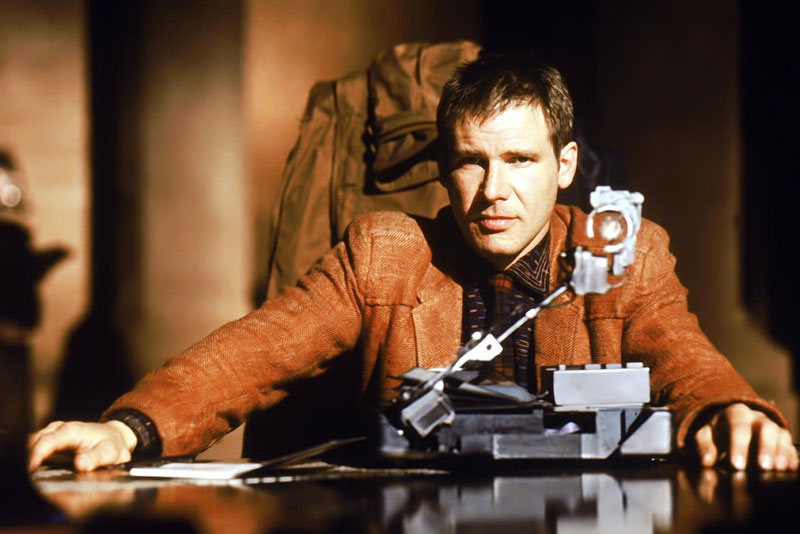
Blade Runner (Ridley Scott, 1982).
Seventeen years later, The Matrix arrived in cinemas, a film that went further, offering much more catastrophic predictions than those presented in Ridley Scott’s work. In this reflection on the future, it was not humans who employed robots as slaves, but artificial intelligence reached such extremes that the machines became parasitic beings that made humans their sources of energy and fuel. To make this possible, they plunged their victims into a dream, a virtual reality in which they lived their lives based on a lie that camouflaged the walls of their prison.
However, this original perspective was not the only ingredient that made this film immortal. The integration of other elements, apparently uncombinable, allowed The Matrix to be more than just another science fiction film, loaded with huge doses of gunfire and kung-fu shots. Its world-building approach, its conception of the concept of the hero, as well as its philosophical orientation allowed it to be presented to the public as a film with an original script, a vision based on Western and Eastern cultural precepts that would generate a tool for entertainment that would also invite reflection and learning.
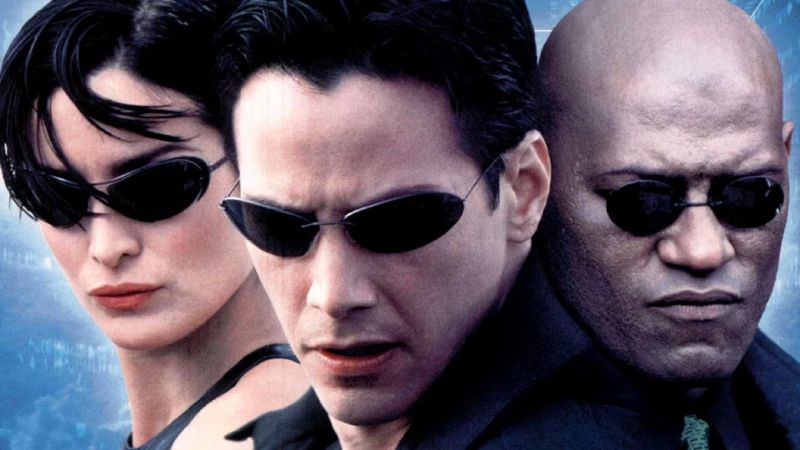
Carrie Anne Moss, Keanu Reeves, and Lawrence Fishbourne, The Matrix starring trio.
Fundamental parts of this work are the philosophical precepts on which the plot is based. Throughout its history, various theories and philosophical currents converge, the most recognizable being Plato‘s cave. This myth, related by the Athenian philosopher in book XII of his work The Republic, takes place in a cave where a group of individuals are tied by their necks, feet, and hands, keeping their gaze fixed on the wall opposite the entrance to the cave. Behind them is a wall that prevents them from seeing what is behind them. On the other side of the wall, men are holding objects aloft to cast the shadow of these objects on the wall at the end of the cavern, using a fire that is still burning beside them.
Because of this forced situation, the prisoners conceive the shadows as their only reality. Since this has been their situation forever, they have no other way of conceiving the world except that, since they have had no other opportunity to know the world outside the cavern. The moment comes, however, when one of the prisoners manages to break his bonds, escape from the cave, and see the world he had previously been unaware of.
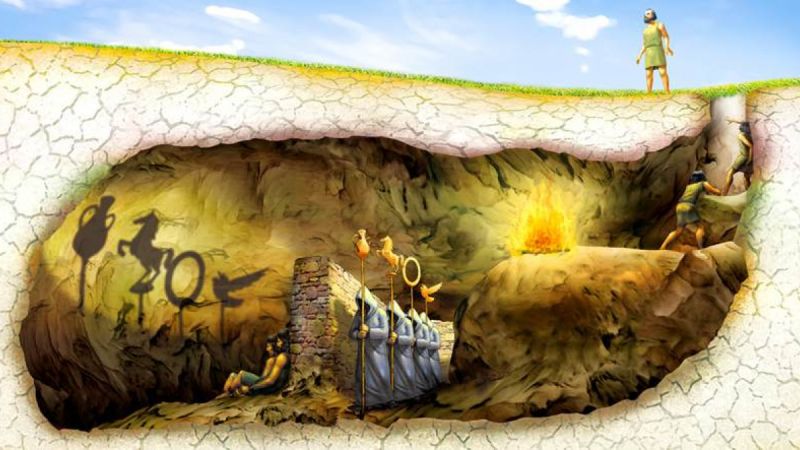
Plato’s cave.
Like the prisoners in the Platonic allegory, the human race is limited in its vision of reality, with computer-designed images projected in its mind, accustomed to and unaware of the reality to which it is alien. They live in a prison in which (in the words of Morpheus, Neo’s master of the Matrix world) they can neither see, hear, taste nor touch.
In fact, the individual who manages to free himself from his bonds, on leaving the cavern, will be momentarily dazzled by the external light, to which he is not accustomed. Neo, on being freed from his cubicle, feels pain in his eyes, as he had never used them before…
However, according to Plato, the prisoner, now free, must return to the cave and explain to his former fellow captives what he has seen, what the world is really like. Morpheus explains to Neo that the Matrix is the enemy and that his goal is to free humanity from its yoke. However, there is one major drawback, and that is that most humans are not ready to be disconnected. Many are so dependent on the Matrix and its digital pantomime that, when the time comes, they would fight to defend their jailers and keep the system alive.
The moral obligation of these rebels is to raise awareness among the inmates of the Matrix; like the man freed from the cave, they must return to convince their former fellow inmates of the world in which they find themselves, to free them from the systemic alienation that keeps them subjugated.
The Matrix is a digital cavern, in which all experience and memory are computer-generated images, a well-oiled alienation machine from which it is difficult to escape and yet which is sometimes missed to the point of longing for one’s former life as an unconscious slave. There is the example of Cypher, whose story we will deal with later.
Despite the intimate and evident relationship between Plato’s cave and the Matrix, we would be falling into the deepest simplism if we were to limit ourselves to point it out as the only philosophical concept present in the plot, as there are several philosophical currents, different and distant in time, that converge throughout Neo’s cyberpunk adventure.
The idea of perception and the discernment of what is real and what is not are two of the key themes within the story in The Matrix. René Descartes, in his Discourse on the Method, expressed his interest in the world of faith and perception, about how one can believe in something that cannot be perceived with our senses. To convince Neo of the susceptibility of the perceptible, Morpheus poses the following reflection to him: Have you ever had a dream, Neo, that seemed very real? What would happen if you couldn’t escape from that dream? How would you differentiate the dream world from reality?
This phrase follows the ideas of the French philosopher, who states that in dreams one experiences sensations as if one were awake, as if they were indeed real. However, it is not until awakening that we realize that they were dreams. So how can we differentiate between those that are real and those that are not? Both Descartes and Morpheus conclude that perception is not evidence that proves the veracity of what is believed.
In order to differentiate between what is real and what is not, Descartes speaks of a powerful and cunning demon that constantly works to deceive you. This idea of the existence of an entity dedicated to the deception of the mind through sensation is very present in The Matrix, forming the fundamental basis of its plot. Humanity is subjected to a continuous bombardment of computer-generated sensations, within a permanent dream devised by an artificial intelligence in order to feed on its energy.
In addition to Plato and Descartes, in the Matrix script, as well as in its sequels, we find nods to Jean-Paul Sartre, the leading exponent of Existentialism. Two of the main ideas that the Parisian philosopher addresses in his work are freedom and choice. In his first conversation with Morpheus, Neo rejects the existence of destiny, denying the idea of not being in control of his own life. Sartre states that the human being is condemned to make decisions, to choose, to the extent that non-choice itself implies a choice. Neo has to make complicated decisions all the time. He has to choose between the blue pill and the red pill, and he has to face up to his decisions, which even lead him to regret them.
In addition to the strong role played by philosophy in this film, religion, and mythology are also very present in The Matrix. Throughout the film, various elements and references to different figures from Christianity and Western (especially Greco-Latin) culture can be perceived, with some components related to Buddhism.
On the one hand, Morpheus represents the figure of a mentor and leader, whose main role in the film is to instruct Neo in the essential fundamentals of the Matrix. His name coincides with that of the Greek god of dreams and his etymological meaning is the one that forms, evidencing his task within the story, to let Neo know that he has lived his whole life in a dream, to give him a new form, the form of the chosen one, of the liberating hero. Trinity embodies a fundamental element in Christian culture: the Holy Trinity. It probably also refers to the triumvirate represented by her, Morpheus, and Neo, the three main heroes of the film.
In contrast to the three previous characters, there is Cypher, the traitor of the story, the one who was disconnected without being prepared, the one who wonders why he didn’t take the blue pill. Cypher is a man who identifies ignorance with bliss and believes that alienation is the key to happiness. He is capable of murdering almost the entire crew of Morpheus and betraying the liberated humans to be cultivated again and be, once again, a slave.
Over the years, there has been much speculation about the symbolism embodied by this character. One interpretation is closely related to Christianity. In English, Cypher coincides with part of one of the incarnations of evil in the Bible, Lucypher, who seduces his victims with superfluous pleasures to lure them away from the word of God and the revelation of truth. Cypher sells his soul to the enemy to once again enjoy those vices that slavery once provided, going further, demanding to be an important person, like an actor. Given that his real name is Reagan, it is likely that he also refers to US President Ronald Reagan, a mediocre actor turned worse politician.
In contrast to Cypher is Neo, the hero of the story. Following in the footsteps of the protagonists of other great sagas such as Frodo, Luke Skywalker, Paul Atreides or Harry Potter, Neo’s story is structured along the lines of what is known as the hero’s journey. This term, coined by the anthropologist and mythologist Joseph Campbell in his famous work The Hero with a Thousand Faces, is based on a pattern that the vast majority of fictional heroes have followed. According to Campbell, the hero begins with an ordinary life, which is cut short when he receives a call to venture into the unknown.
Neo (Keanu Reeves), officially known as Thomas A. Anderson, is a programming expert working for a major software company who combines his role as an exemplary worker with that of a hacker, finds his humdrum life cut short when he receives a strange message on his computer. By following this clue and taking the red pill, he will cross what is called the threshold into the unknown (the human breeding grounds and the revelation of the Matrix), initiating a new phase that will shape his new identity, a process that will involve a mentor (Morpheus) and a helper (Trinity). Neo will go through a series of challenges that will shape him into the hero he aspires to be: the long-awaited leader who will free humanity from slavery.
The figure of Neo is charged with a marked messianic character, like many other protagonists of great sagas. His very name as a hacker already hints at his destiny (Neo is the One in reverse, the chosen one in English). In the culture of Zion, the only redoubt of free human presence in the world, there is a prophecy about the arrival of a chosen one, a man endowed with the power to manipulate the Matrix at will who would free humanity from prison. This liberating messiah status is reaffirmed in the denouement of the third installment, where Neo sacrifices his own life to achieve his liberating goal.
At the end of his adventures, when Neo is fully aware of his chosen status, he addresses the machines in a final monologue, in which he makes clear his intention to do away with the repressive system created by them. In Neo, the figure of Jesus of Nazareth and Plato’s exile from the cave converge. A Messiah who has come into the world to reveal the truth to humanity, to redeem and liberate it, promising a kingdom in which there will be no limits or repression of any kind.
Despite the ingenious construction of the hero concept in The Matrix, in the two subsequent installments, Neo’s messianic side is shown in a very superficial way, focusing more on depicting a superhero who stands out for his power and ultimate sacrifice, in a clear reference to Christ, rather than showing his side as a messenger who reveals the truth. Perhaps one of the biggest mistakes of Matrix Reloaded and Matrix Revolutions is such a banal view of Neo, presenting him as an action hero, whose only abilities to save the world are Kung-fu bashing and defying the laws of nature.
Neo’s main nemesis in this story is Smith (Hugo Weaving), an FBI agent of sorts, whose law enforcement appearance hides a computer program capable of sensing, whose purpose is none other than to maintain order in the Matrix. Curiously, Smith is just another cog in the wheel, not the dark lord responsible for all the suffering humanity must endure. He is just another puppet, a mental jailer of a system endowed with very long tentacles.

Agent Smith, is the main antagonist in The Matrix.
The principle of control, as Smith’s essential foundation, revolves around a key idea: the inferiority of the human being, a species enslaved by its own instincts and passions, an ideological code that could well be related to the philosophical school of Stoicism, especially to the idea of apátheia, apathy or mastery of the passions, or even Thomas Hobbes‘ principle that man is a wolf to man, hence the need for the existence of a controlling authority.
Smith is a staunch believer in his cause, a staunch advocate of control, and a symbol of blind trust free from the spectre of reason. According to his code, mind control is a necessary tool for the guarantee of happiness, since human beings cannot be happy being endowed with the ability to make their own decisions. Cifra buys this argument by pointing to ignorance as the equivalent of happiness.
Another character present in the story, and the most recognizable Ancient Greek character, is the Oracle (Gloria Foster). Embodied as a gentle and endearing biscuit-baking lady, she is nothing more than a computer program, the only ally of the human race within the Matrix. Like her Delphic counterpart Pythia, she is endowed with the power to predict the future, so the various heroes of the story go to her to consult her about their destiny.
Ironically, Neo does not believe in fate, yet he goes to a fortune-teller to find out if he is indeed the chosen one. The interest of this scene lies in the main message it preserves. As in the pronaos of the temple of Apollo at Delphi, above the kitchen door of this computer program, the phrase Temet Nosce, “know thyself”, can be read in Latin. This idea, followed by many philosophers, advocates the need to find out one’s conditions, one’s capacities, and defects.
Neo is not entirely sure that he is the chosen one, so the Oracle decides to lie to him and warn him of the events that are about to unfold. He will hold Morpheus’ life in one hand and his own in the other, and he will have to choose. Later, Neo, aware that he is not the chosen one, decides to risk his own life to save that of his mentor. It is at this moment that he comes to know himself, when he is fully aware of his capabilities, reaffirming, moreover, Sartre’s principle of freedom of choice.
Beyond the brilliance of the design of the Matrix universe, in terms of its philosophical foundations and its links with essential figures of Western culture, its quality as a work of science fiction is not only limited to this aspect, but can also be appreciated in the way it aesthetically conceives its narrative foundations, especially when it comes to representing those scenes that take place in the real world and those that take place in the Matrix, one of the most subtle and, at the same time, most intelligent stylistic resources. The sequences that take place in the world of the Matrix have a green filter, a clear allusion to the computer screens of the time, while in the real world, there is no such filter. Agent Smith, a key player in the dream world, wears a black suit with a greenish tint.
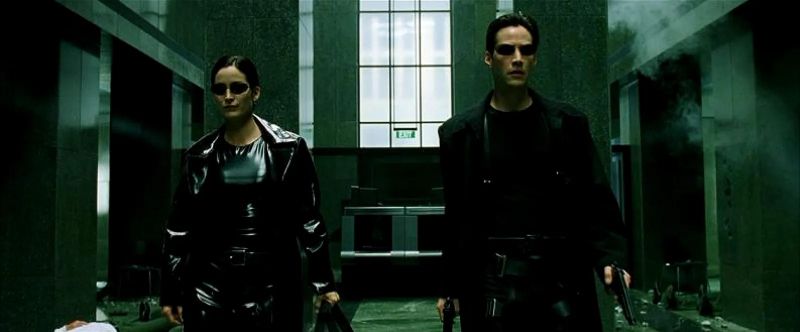
Sunglasses and green filters, indicators that the action takes place in the Matrix.
In addition, as a final detail, whenever the characters are in the Matrix, they wear sunglasses, indicating that their vision is limited and filtered by the influence of the world of illusions in which they find themselves. In fact, at the end of the film, Neo’s sunglasses are almost transparent, indicating that he, as the chosen one, can see what others cannot, the innards of the Matrix.
Science fiction, in short, can entertain more or less, it can criticise or predict more or less accurately the future it speculates in its stories. But in the case of The Matrix, it not only invites us to reflect on the future, but also on the very existence of human beings from different perspectives, using ingenious and subtle philosophical references, seasoned with incredible action scenes. Entertainment and learning, that’s all you could ask for.
Now we have to ask ourselves, are we awake?

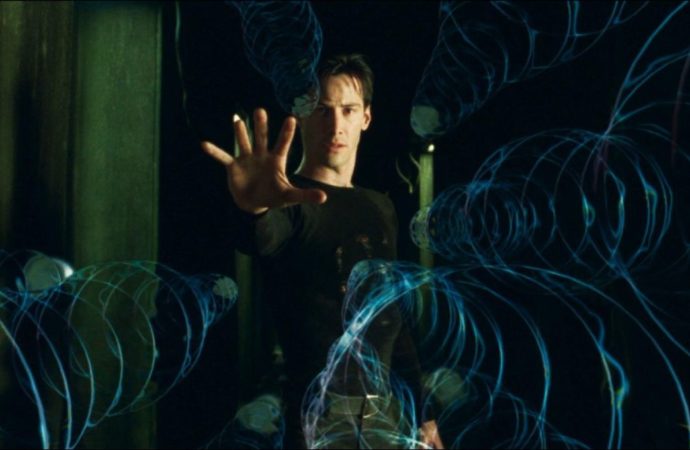
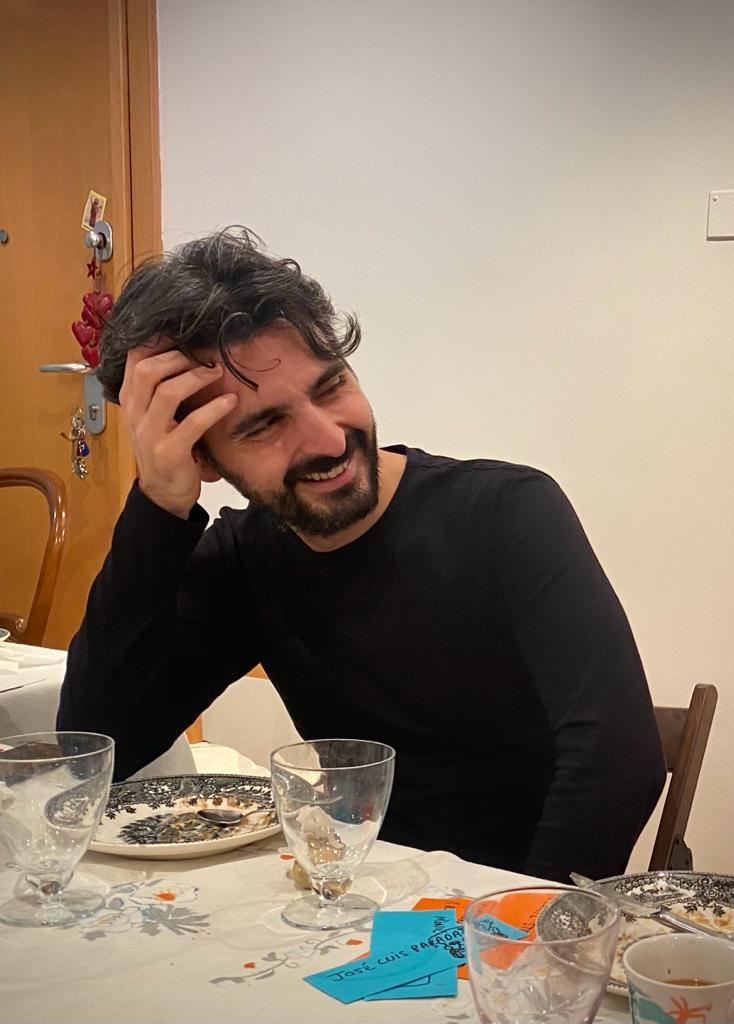
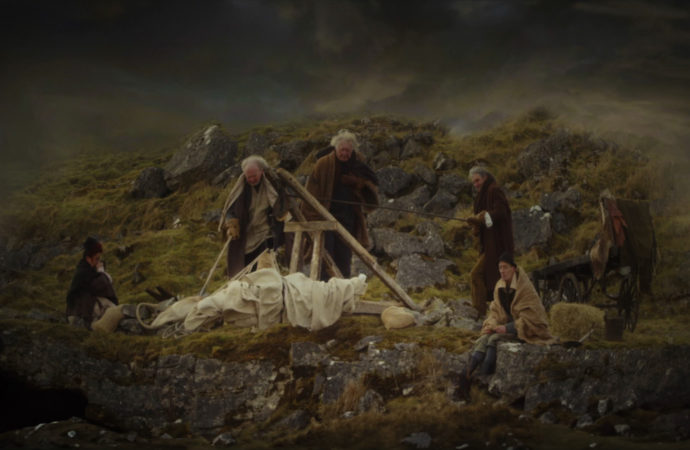



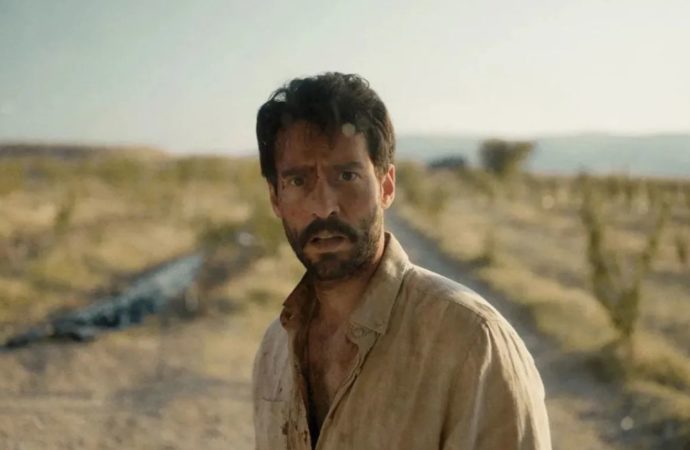

No one has posted any comments yet. Be the first person!